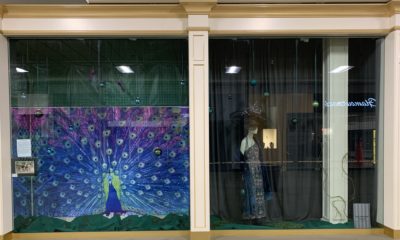CREATING A CONNECTION with consumers can be achievable in this digital age, but making one that truly humanizes a brand can be a constant challenge. Look no further than transporting the consumer down memory lane. Whether it is the ’70s, ’80s or ’90s, referencing happy and positive experiences can create leverage, and integrating nostalgic feelings and references can put customers at ease.
The concept of “nostalgia” has been identifiable within the built design industry, and more specifically, on the runways and in store interiors — and there is no sign of these references stopping, even as we prepare to head into 2018.
Take for instance the graphic comic book references on the set of Prada’s spring/summer menswear collection (the collection itself featured very pronounced popped collars, a trend that may have been more widely observed during the preppy looks of the 1980s). Patchwork has been cropping up throughout various designer lines across the globe, and it’s evident that retro sweaters and corduroy textiles are also making a comeback. Gucci has highlighted the formerly frowned upon Fanny pack, which could quickly become one of the upcoming season’s most coveted fashion accessories.
We know that creating an inviting and welcoming store environment and pairing it with an immersive experience increases dwell time, but layering in a very clear sense of nostalgia, almost as if a space was frozen in time, can truly resonate with the customer. How quickly a person becomes relaxed in a space when they start to feel at home and fond memories start coming to mind.
Hermès recently created a laundromat-themed pop-up in New York. Other prominent examples of the use of nostalgia in design include The Wedgwood UK Tea Conservatory pop-up at Peter Jones Sloane Square in London, or the Ah-chu Ice Cream Café by Wonderlust in Gimp, South Korea. All of these locations scream specific eras where the customer can quickly transport themselves back in time, while establishing current, present day memories and connections for new generations of guests.
While designers have access to various types of data and analytics, marketing and design departments can look toward references from the past as jumping off points for their next store projects. And, who knows, that next great idea may perhaps lie within the pages of an old photo album or in a pattern from a vintage clothing piece, and it will not just be the millennials that will take notice.
Advertisement
Want to learn more about nostalgic design? Be sure to join us at the International Retail Design Conference (IRDC) this September 5-8 in New Orleans to take part in our interactive workshop on the subject. For more information, please visit irdconline.com.
 |
Don’t miss Karen and Diane’s session at VMSD‘s International Retail Design Conference (IRDC), Sept. 5-8, in New Orleans. Their hands-on workshop, “Nostalgic Notes: Think, Pair, Share,” taking place Thursday, Sept. 7, at 1:35 p.m., will focus on an audience-centric design challenge using the idea of “nostalgia” as the main ingredient. For more information about their session and others, visit irdconline.com. |
Diane Spiridoulias is a passionate professor in the Visual Merchandising Arts program at Sheridan College in Canada. As a seasoned art director with over 18 years of experience, as well as maintaining a proven track record for translating complex ideas into slick, and successful designs for the beauty and fashion retail sectors, Diane is skilled in developing external client relationships, graphic design and styling. The diversity of her work reveals her ability to apply design skills in innovative ways that elevate brand and design excellence. Previous work experiences include Seven Continents and Sirens, a division of YM Inc. Diane holds a diploma from Sheridan in Visual Merchandising Arts and is currently working towards obtaining her Bachelor of Professional Arts Communication Studies at Athabasca University.
Karen Kritzer is a professor at Sheridan College where she is also part of the Program Support Team for various design courses. This career path has allowed her to balance teaching alongside freelance work, keeping her up to speed with the industry. As a small business owner and freelance visual merchandiser, Karen can relate to the everyday challenges that retailers face. Working with both top name brands and small independent retailers has allowed Karen to create unique action plans that achieve results for her clients. Just shy of 10 years with IKEA Canada, she worked as part of the Communications and Interior Design Team. Recently her work with CanGift Toronto as a seminar host, paired with retail consultations, has allowed her to keep in contact with entrepreneurs and retailers from across the country.






































